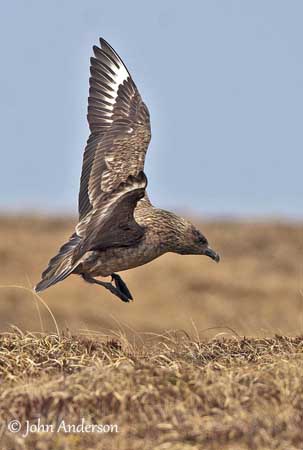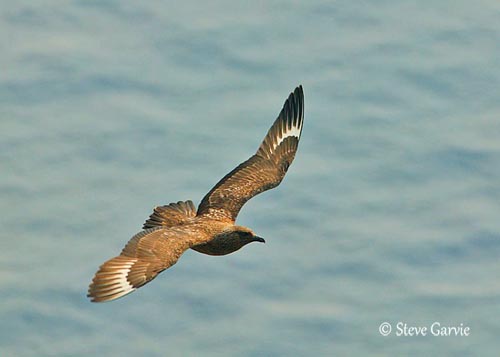
Fr: Grand labbe
Gaélique: Bonxie, Fàsgadair Mòr, Fasgadair Mor Tuilleag, Fàsgadan
All : Skua
Esp : Págalo Grande
Ital : Stercorario maggiore
Nd: Grote Jager
Norv : Storjo
Sd: Storlabb
Photographers:
John Anderson
John Anderson Photo Galleries
Steve Garvie
RAINBIRDER Photo galleries
Text by Nicole Bouglouan
Sources:
HANDBOOK OF THE BIRDS OF THE WORLD Vol 3 by Josep del Hoyo-Andrew Elliott-Jordi Sargatal - Lynx Edicions - ISBN : 8487334202
SKUAS AND JAEGERS by Klaus Malling Olsen and Hans Larsson - Pica Press Sussex,
ISBN: 1873403461
THE HANDBOOK OF BIRD IDENTIFICATION FOR EUROPE AND THE WESTERN PALEARCTIC by Mark Beaman, Steve Madge - C.Helm - ISBN: 0713639601
L’ENCYCLOPEDIE MONDIALE DES OISEAUX - Dr Christopher M. Perrins - BORDAS - ISBN: 2040185607
THE COMPLETE BOOK OF BRITISH BIRDS – Written by “Royal Society for the Protection of Birds” experts - Préface de Magnus Magnusson - Michael Cady- Rob Hume Editors - ISBN: 0749509112
BirdLife International (BirdLife International)
Great Skua
Stercorarius skua
Charadriiforme Order – Stercorariidae Family
BIOMETRICS:
Length: 53-58 cm
Wingspan: 132-140 cm
Weight: 1100-1700 g
DESCRIPTION:
The Great Skua is opportunistic. It often attacks other seabirds to steal their preys and may kill them too, during the breeding period. Outside this season when staying offshore, it feeds primarily by pirating food from gannets and gulls.
This species appears like the most ferocious of this family.
It is often called “Bronxie” the traditional Shetlanders’ name.
The adult has brown plumage overall. On the upperparts, mantle, scapulars and upperwing-coverts are brown to dark brown with paler spots or short streaks, usually yellowish or buff, occasionally whitish. Markings may vary.
The flight feathers are blackish with white bases of primaries, very conspicuous in flight and during displays. The tail is blackish, but in fresh plumage, rectrices show narrow pale edges.
The underparts, from chin to undertail-coverts, are buff, pale brown, grey-brown or dark brown, occasionally rufous. It may show exceptionally a broad, indistinct dark breast band. Belly and undertail-coverts are slightly darker, sometimes with faint darker streaking. Underwing-coverts are dark brown, but primary and greater coverts are dark greyish with indistinct darker tips. The white extension at bases of primary flight feathers is more diffuse than above.

On the head, the plumage varies individually. Some birds have dark brown crown contrasting with paler yellow-streaked head sides. But the head may be pale greyish-brown with dark mask restricted to the area around eye and ear-coverts. The rear of ear-coverts is paler.
The Great Skua usually shows irregular white, yellow or buff spotting, mainly on crown. But lores, forehead and chin are often paler than rest of head. Nape, neck sides, chin and throat (and occasionally breast), show pale grey, pale yellow or golden narrow shaft-streaks.
The stout hooked bill is blackish, with sometimes pale grey tip. Eyes are dark brown. Legs and webbed feet are black.
During winter, the plumage is similar but the head is darker brown with weaker pale streaking on neck sides and darker mask around the eyes.
Both adults are similar. They tend to become paler with the age.
The juvenile resembles adult but it has much darker and more uniform plumage. The colour of the body varies from chestnut to brown. The white wing panel is less conspicuous.
VOICE: SOUNDS BY XENO-CANTO
The Great Skua is noisy during the breeding season, whereas it is silent at sea and during winter. It utters plaintive, nasal, wailing calls “piah piah piah piah” when threatening or attacking intruders. The alarm call is a short, harsh “tuk” or “gek”. During dive-bombing attacks on intruders, it gives a strangled “kayaya”.
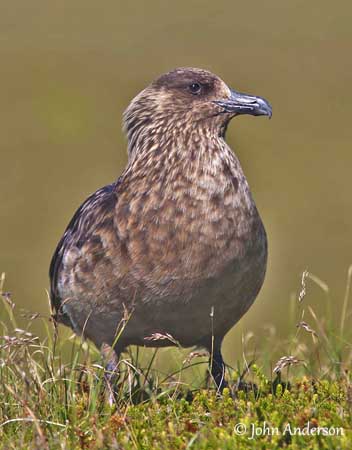
HABITAT:
The Great Skua is marine and migrates more over water than over land. During winter, it can be found in flocks a few kilometres offshore, and they gather close to areas where they can scavenge from fisheries.
This species breeds on islands, on flat ground with some vegetal cover. They breed in loose colonies of up to several hundreds of pairs.
RANGE:
The Great Skua breeds in Iceland, Faeroes and N Scotland. A northwards spread along Norwegian coast to Svalbard, Bear Island, Jan Mayen and into Kola Peninsula has been reported since 1969s.
This species winters off Iberia. The young birds may move as far S as Cape Verde Islands and Brazil. Small numbers reach Grand Banks of Newfoundland.
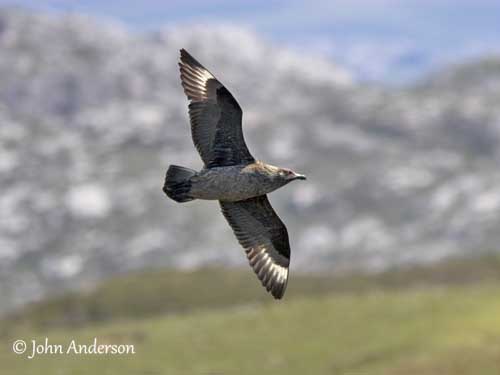
BEHAVIOUR:
The Great Skua is an opportunistic feeder. It feeds on fish caught by surface-plunging, but it also gets food from trawlers, it scavenges on dead birds, and steals food from other seabirds such as gannets and auks. It persecutes and kills seabirds suck as Black-legged Kittiwakes and Atlantic Puffins, and also takes their eggs and young.
In Iceland and NW Scotland, it feeds on squid and more seabirds.
During winter, its diet includes discarded food from fishing boats, scavenging, stolen preys, and it catches its own fish, especially sand-eels (Ammodytes). It kills small mammals too.
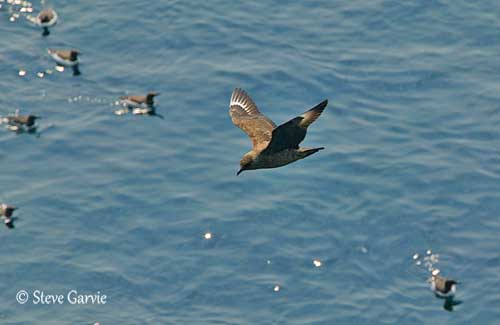
During the breeding season, the Great Skua performs aggressive, threat and courtship displays.
This large bird often squabbles where they gather at food sources. The typical displays involves wing-rising, in order to expose the white wing patches.
The “long-call” is used to establish the territory, and is typically accompanied by the same “wing-rising display”.
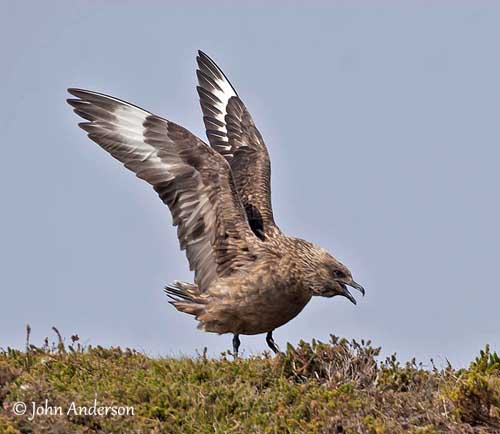
The territorial defence is very strong when breeding. Each pair defends its territory, attacking as well animals as humans. They peck and strike them at head to chase them away from the nest-site.
They are usually monogamous and pair for life, with strong territory site fidelity. Pairs often re-establish the pair-bonds when meeting on their usual territories. Courtship displays are limited, but both mates call facing each other, with head and neck slightly tossed backwards and bill upwards.
If an intruder tries to enter the colony, physical attacks and fights may involve serious injuries.
The Great Skua is a long-lived species, up to 34 years.
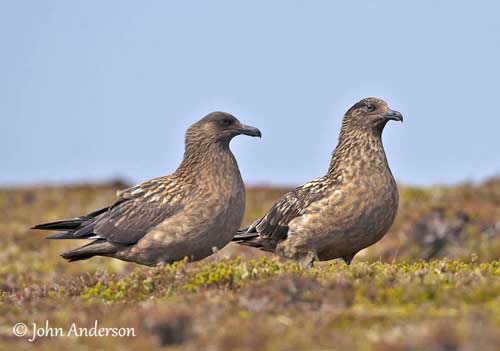
This species migrates S to winter off Iberia. They leave their breeding grounds in August-September and move slowly southwards. They return to the breeding areas in March-April.
FLIGHT:
The Great Skua performs active, steady flight with slow wingbeats, and very occasional brief glides. Even over the waves, the flight remains active. When soaring, the bird flaps its wings frequently and for long periods. In piratical flight, large seabirds are chased with great agility.
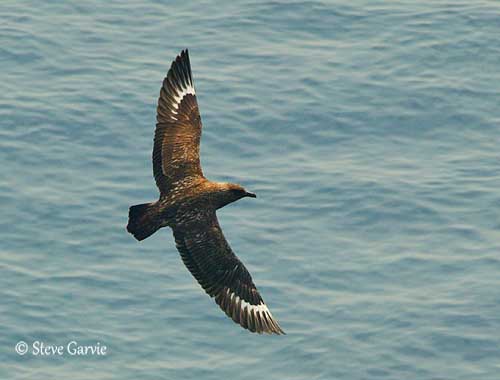
REPRODUCTION:
The reproduction starts in May. The Great Skua is loosely colonial. The nest-site is on the ground, a scrape often lined with dry grasses in open area and broken terrain with grass, and wet moorland with higher places to survey the surroundings.
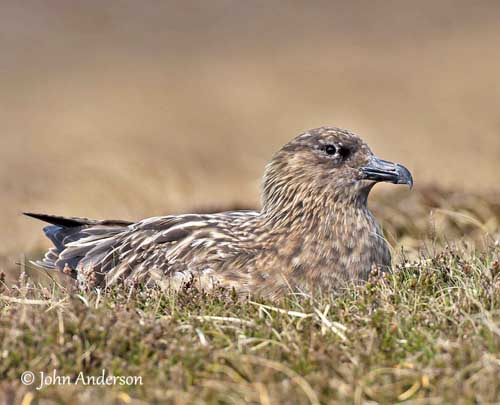
The female usually lays two pale buff eggs with dark brown spots. Incubation lasts 28-32 days. At hatching, chicks are covered in uniform pale pink-grey brown down. They are precocial and leave the nest 24-48 hours after hatching. They fledge about 40-50 days later. They are sexually mature at 7-8 years.
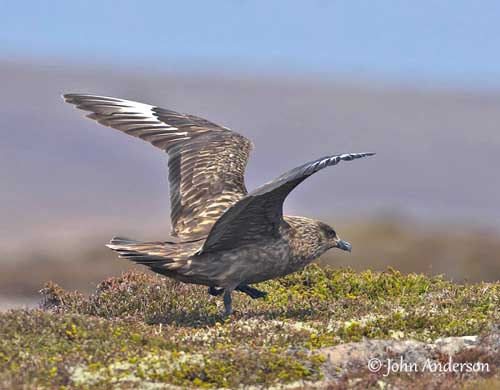
DIET:
The Great Skua feeds on fish caught by surface-plunging, but this opportunistic species feeds mainly by stealing food from other seabirds which are heavily persecuted until they regurgitate the food. The Great Skua also gets food from trawlers and fishing-boats, and scavenges on dead birds. It may take eggs and young of other seabirds, and kills small mammals and birds.
PROTECTION / THREATS / STATUS:
The Great Skua has stable populations. In absence of evidence for declines or potential threats, this species is currently considered not threatened, and evaluated as Least Concern by BirdLife International.
